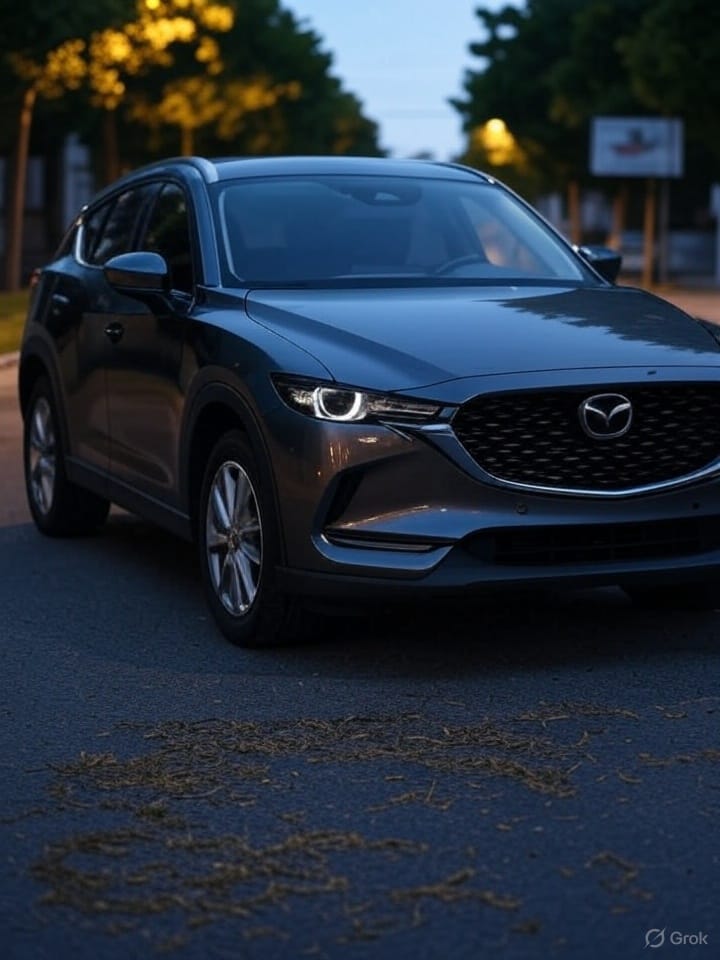Luxury on a Budget: How the Mazda CX-5 Competes with Premium SUVs in Kenya

Let's talk about that moment when you're scrolling through SUV listings and your budget is saying "Toyota Probox" but your heart is screaming "Range Rover Evoque."
You want leather seats that don't crack after six months. A sound system that doesn't sound like it's underwater. Ground clearance that laughs at Nairobi's potholes. And maybe—just maybe—a car that makes your neighbours go "Eeh, huyu amepanda" when you park outside.
Your options? The usual suspects:
- Toyota RAV4—reliable but predictable.
- Subaru Forester—practical but, let's be honest, not everyone’s cup of tea.
- VW Tiguan—fancy but with a maintenance budget that might require you to sell a kidney.
Then there's the Mazda CX-5.
"Mazda?" you think. "Isn't that the brand that makes those small cars?"
Eeh, my friend. Prepare to have your mind blown.
The CX-5 has been quietly revolutionising what "luxury on a budget" means in Kenya's SUV market. It's giving premium vibes without the premium price tag, and honestly? It's about time someone talked about it.
The David Among Goliaths
Let's be real about Kenya's SUV hierarchy. At the top, you have the German luxury brands—Audi Q5, Mercedes-Benz GLC, BMW X3, among others—beautiful machines that cost more than some people's houses.
In the middle, there's the Japanese reliability crew: RAV4, Forester, CR-V. These are safe choices that won't surprise you, for better or worse.
Then there's the CX-5, sitting comfortably in that sweet spot where luxury meets affordability, laughing at everyone trying to figure out how it does it, or it could just be me having a sentimental attachment to the model 🤭.
The Numbers Don't Lie
In Kenya's market, a decent CX-5 (2017-2020) ranges from KSh 2.5M to KSh 8.2M depending on year and trim. Compare that to:
- RAV4 (similar year): KSh 3.2M to KSh 9.5M
- Subaru Forester: KSh 2.8M to KSh 8.8M
- VW Tiguan: KSh 3.5M to KSh 11M
Already, you're saving money upfront. Might not look like much, but that’s fuel for a whole damn year. But wait—there's more.
Design: When Cars Become Art
Walk around a CX-5 and you'll understand why Mazda calls their design philosophy "Kodo." It means "Soul of Motion," and honestly, it shows.
The CX-5 looks like it told its manufacturer, “Bro, make me look good, but on a budget.”
While the RAV4 looks like it was designed by a committee of engineers (functional but uninspiring - honestly), and the Forester seems to prioritise practicality over pizzazz, the CX-5 looks like it actually wants to be driven.
Interior Game Strong
Step inside a well-specced CX-5 XDL package and you're greeted with:
- Premium leather seats that don't feel fake
- A Bose sound system that makes your Spotify playlist sound like a concert
- Heated seats (because Nairobi mornings can be chilly, surprisingly)
- Unlike some Tiguan imports with sealed panoramic roofs, the CX-5’s sunroof is often fully operational in XDL trims
Compare this to a RAV4's interior—functional, yes, but about as exciting as watching paint dry. The Forester tries harder but still feels like your accountant picked the materials. The Tiguan? Beautiful, but good luck finding affordable replacement parts when something breaks.
Performance: More Than Just Pretty Looks
Here's where the CX-5 gets interesting. Mazda didn't just make it look good—they made it drive good too.
Engine Options That Make Sense
The diesel variants (2200cc-2500cc) deliver up to 18 km/L. Depending on your driving habits, the CX-5 diesel could save you up to KSh 100,000 annually in fuel compared to rivals like the Tiguan.”
Let's break this down:
- CX-5 Diesel: ~18 km/L
- RAV4 (2.0L): ~14 km/L
- Forester (2.0L): ~13 km/L
- Tiguan (2.0L): ~12 km/L
Over a year, if you're driving 20,000 km (typical for Nairobi professionals), the CX-5 uses about 1,111 litres of fuel vs. the Tiguan's 1,667 litres. At current diesel prices, that's real money saved.
Handling: The Sweet Spot
The CX-5's chassis strikes a beautiful balance. It's not as soft as the RAV4 (which feels like driving a couch), not as stiff as the Tiguan (which thinks every pothole is a personal insult), and more refined than the Forester (which sometimes feels agricultural).
On Kenyan roads—from smooth Thika Highway to the crater-filled side streets of Eastlands—the CX-5 handles with confidence and composure.
Tech and Safety: Where Value Meets Innovation
This is where the CX-5 really flexes on its competition.
Safety First
Euro NCAP 5-star rating isn't just marketing speak—it's peace of mind. The CX-5 comes standard with:
- Advanced airbag systems
- Electronic stability control
- Hill-start assist (crucial for Nairobi's many slopes)
- Smart city brake support
The RAV4 matches this, the Forester comes close, but the Tiguan? You'll pay extra for most advanced safety features.
Tech That Actually Works
Apple CarPlay and Android Auto come standard on most CX-5 variants. The 360-degree camera system is genuinely helpful for parking in tight Nairobi spaces (and trust me, all Nairobi spaces are tight).
The infotainment system is intuitive. The rotary knob system is safer than touchscreens while driving, though it may take some getting used to.
i-Activ AWD: The Secret Weapon
Mazda's AWD system is intelligent. It doesn't just send power to all wheels—it predicts when you'll need it. Approaching a slippery section? It's already prepared. Navigating through Nairobi's infamous potholes? It adjusts.
This isn't just marketing fluff. On Kenya's diverse terrain—from city streets to safari roads—this system provides confidence that front-wheel-drive competitors simply can't match.
Cost of Ownership: The Real Test
Buying the car is just the beginning. The real question is: what happens after?
Maintenance Reality Check
Mazda has significantly improved its parts availability in Kenya. Major services cost approximately:
- CX-5: KSh 15,000-25,000 per service
- RAV4: KSh 18,000-28,000 per service
- Forester: KSh 16,000-26,000 per service
- Tiguan: KSh 25,000-45,000 per service (ouch)
The CX-5's SkyActiv-D diesel engine is designed for longevity. While generally reliable, the diesel CX-5 requires high-quality fuel and regular servicing to avoid DPF (diesel particulate filter)-related issues.
Insurance Costs
Insurance companies love the CX-5's safety rating. Comprehensive cover typically costs 15-20% less than equivalent German SUVs, while remaining competitive with Japanese alternatives.
Spare Parts Availability
This is where Mazda has done serious homework. Unlike the early 2000s when finding Mazda parts required archaeological skills, today's CX-5 parts are readily available in Nairobi and major towns.
Common service items (filters, brake pads, oils) are competitively priced and widely stocked.
Resale Value: The Long Game
Let's address the elephant in the room: Mazda's resale value historically lagged behind Toyota and Subaru in Kenya.
But here's the plot twist—this is changing, and fast.
Market Perception Shift
As more Kenyans experience the CX-5's quality and reliability, demand is growing. Recent market analysis shows CX-5 models holding their value better than expected:
- 3-year-old CX-5: Retains ~65% of original value (yes, while Toyota still leads in resale, the CX-5 is closing the gap—especially among younger buyers seeking style and tech.
- 3-year-old RAV4: Retains ~70% of original value
- 3-year-old Forester: Retains ~68% of original value
- 3-year-old Tiguan: Retains ~60% of original value
The gap is narrowing, and the CX-5's superior initial value proposition means your total cost of ownership remains competitive even with slightly lower resale values.
Urban Professional Appeal
The CX-5 attracts a specific demographic—urban professionals who appreciate design, efficiency, and technology. This creates a strong secondary market, especially in Nairobi and Mombasa.
The Honest Truth: Where CX-5 Falls Short
Let's keep it 100—no car is perfect, and the CX-5 has its limitations.
Brand Perception
In Kenya, Toyota still rules the reliability perception game. When you say "RAV4," people nod approvingly. When you say "CX-5," some still ask, "Ni gani hiyo?"
This is changing, but slowly.
Service Network
While improving, Mazda's service network isn't as extensive as Toyota's or Subaru's. In smaller towns, finding authorised service centres might require some planning.
Cargo Space
The CX-5 prioritises style over maximum utility. If you need to carry eight people or massive cargo regularly, the Forester or RAV4 might serve you better.
The Verdict: Smart Money, Smart Choice
The CX-5 represents something rare in Kenya's automotive landscape—genuine luxury at a reasonable price.
It's for the buyer who wants more than transportation. Who appreciates good design, values efficiency, and enjoys driving rather than just enduring it.
You Should Consider the CX-5 If:
- You want premium features without premium prices
- Fuel efficiency matters to your budget
- You appreciate good design and build quality
- You drive primarily in urban/suburban settings with occasional off-road adventures
Stick with Alternatives If:
- Maximum cargo space is your priority
- You absolutely must have the highest resale value
- You live far from major service centers
- You prefer the "tried and tested" approach to car buying
The Bottom Line
In Kenya's SUV market, the Mazda CX-5 isn't trying to be everything to everyone. Instead, it's perfected the art of being exactly what many buyers actually need—luxury on a budget, efficiency without compromise, and style with substance.
It's not the obvious choice, but increasingly, it's the smart choice.
Your wallet, your fuel gauge, and your passengers will thank you.
Ready to explore the CX-5 and other premium SUVs? Browse our inventory or read everything there is to know about cars in our comprehensive guides.




